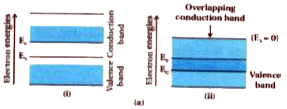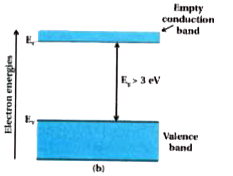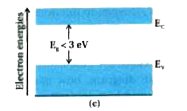Explain conductor (metal), insulator and semiconductor by drawing diagrams based on band. Solution in Gujrati
Atomic number of Si is 14. The electron configuration of silicon atom is 1s22s22p63s23p2 hence K and L shells are completely filled and M shell is incomplete and there are 3s23p2 valence electron in it.
And atomic number of Ge is 32. The electron configuration of silicon atom is 1s22s22p63s23p63d104s24p2 hence K, L and M shells are completely filled and N shell is incomplete and there are 4s24p2 valence electron in it.
Hence both Si and Ge semiconductor are tetravalent.
There are total 4 electrons in outermost orbit of Si or Ge crystal. The maximum possible number of electron in the outer orbit is 8(2s+6p electrons).
So, for the 4N valence electrons there are 8N energy states.
These 8N discrete energy levels can either form a continuous band or they may be grouped in different bands depending upon the distance between the atoms in the crystal.
At the distance between the atoms in the crystal lattices of Si and Ge, the energy band of these 8N states is split apart into two which are separated by an energy gap Eg, which is shown in the figure below.

The energy band positions in a semiconductor at 0 K.
The upper band called the conduction band, consists of infinitely large number of closely spaced energy states.
The lower band called the valence band, consists of closely spaced completely filled energy states.
The lower band which is completely occupied by the 4N valence electrons at temperature of absolute zero is the valence band and there is an upper conduction ban with 4N energy levels, which is completely empty at absolute zero temperature.
The lowest energy level in the conduction band is shown as Ec and highest energy level in the valence band is shown as Ev. Above Ec and below Ev there are a large number of closely spaced energy levels as shown in figure.
The gap between the top of the valence band and bottom of the conduction band is called the energy band gap (Energy gap Eg). It is known as forbidden gap.
Depending on the type of material, forbidden may be small, large or zero, depending on this gap the following three types are available.
Case I Metal (conductor) :

According to (i) and (ii) in figure (a) one can have a metal either when the conduction band is partially filled and the valence band is partially empty or when the conduction and valence bands overlap.
When there is overlap electrons from valence band can easily move into conduction band.
When the valence band is partially empty, electrons from its lower level can move to higher level making conduction possible. Therefore, the resistance of such materials is low or the conductivity is high.
Case II Insulator:

According to figure (b), the distance between the valence band and the conduction band is very large means energy gap Eg>3eV, there is no electrons in the conduction band as well as raising the temperature, electrons cannot be send from the valence band to the conduction band therefore, such a material does not carry electricity such material is called insulator.
According to figure (c ), such a material has an energy gap (Eg<3eV).
The region between valence band and conduction band is small so at room temperature some electrons from valence band can acquire enough energy to cross the energy gap and enter the conduction band.
These electrons (through small in numbers) can move in the conduction band, therefore the conduction of charge flow is reduced. Such materials are called semiconductor.
Energy gap in semiconductor Eg<3eV. The value of Eg for Si is 1. 1 eV and the value of Eg for Ge is 0.7 eV.
Topper's Solved these Questions
- SEMICONDUCTOR ELECTRONICS : MATERIALS, DEVICES AND SIMPLE CIRCUITS BOOK - KUMAR PRAKASHANCHAPTER - SEMICONDUCTOR ELECTRONICS : MATERIALS, DEVICES AND SIMPLE CIRCUITS EXERCISE - Section-B : Numericals (Numerical From Textual illustrations)
16 Videos
- SEMICONDUCTOR ELECTRONICS : MATERIALS, DEVICES AND SIMPLE CIRCUITS BOOK - KUMAR PRAKASHANCHAPTER - SEMICONDUCTOR ELECTRONICS : MATERIALS, DEVICES AND SIMPLE CIRCUITS EXERCISE - Section-B : Numericals (Numerical From Textual Exercise)
15 Videos
- SEMICONDUCTOR ELECTRONICS : MATERIALS, DEVICES AND SIMPLE CIRCUITS BOOK - KUMAR PRAKASHANCHAPTER - SEMICONDUCTOR ELECTRONICS : MATERIALS, DEVICES AND SIMPLE CIRCUITS EXERCISE - Section-D : Multiple Choice Questions (MCQs) (MCQs asked in Competitive Exams)
129 Videos
- SAMPLE QUESTION PAPER BOOK - KUMAR PRAKASHANCHAPTER - SAMPLE QUESTION PAPER EXERCISE - PART-B SECTION-C
5 Videos
- WAVE OPTICSBOOK - KUMAR PRAKASHANCHAPTER - WAVE OPTICSEXERCISE - SECTION-D (MULTIPLCE CHOICE QUESTIONS (MCQS)) (MCQS FROM DARPAN BASED ON TEXTBOOK)
239 Videos
Similar Questions
C, Si and Ge have same lattice structure. Why is C insulator while Si and Ge intrinsic semiconductors?
View SolutionIn an n type silicon, which of the following statements is true:
View SolutionAt absolute zero temperature Si acts as ……..
View SolutionTwo charges –q and +q are located at points (0, 0, –a) and (0, 0, a), respectively.
(a) What is the electrostatic potential at the points (0, 0, z) and (x, y, 0) ?
(b) Obtain the dependence of potential on the distance r of a point from the origin when r/a>>1 .
(c) How much work is done in moving a small test charge from the point (5,0,0) to (–7,0,0) along the x-axis? Does the answer change if the path of the test charge between the same points is not along the x-axis?
View SolutionAccording to particle theory of light what is the velocity of light in a dense medium, compared to that in rare medium ?
View SolutionDistinguish between conductor (or metals), semiconductors and insulators on the basis of theur energy bands.
View Solutionऊर्जा - बैण्ड चित्र के आधार चालक , अचालक एवं अर्द्धचालकों में अंतर स्पष्ट कीजिये ।
View SolutionExplain the formation of energy band diagram in case of conductor and semiconductor.
View SolutionBased on band theory, explain why metals are good conductors of electricity, while insulators are non-conductors of electricity.
View SolutionClassify metals, semiconductors and insulators based on the band theory of solids.
View Solutionबैण्ड सिद्धांत के आधार पर चालक, अर्धचालक और कुचालक को समझाइए तथा ऊर्जा आरेख बनाइए।
View SolutionOn the basis of band theory , explain the difference between conductor , insulator and semiconductor.
View SolutionDistinguish between a conductor , a semiconductor and an insulator on the basis of energy band diagrams.
View Solutionठोसो मे ऊर्जा बैण्ड के निर्माण की व्याख्या कीजिए I (i) एक चालक (ii) एक नैज अर्द्धचालक के लिए ऊर्जा बैण्ड आरेख बनाइए।
View SolutionClassify solids into conductors, semiconductors and insulators by drawing energy diagram.
View Solution
